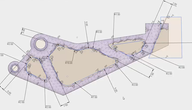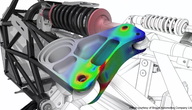You are here
It is important to understand your sustainability goals before using FEA. There are many aspects of sustainability that can be investigated, but the overarching aim for all of them is to reduce the impact of your product.
Fortunately, there are many ways in which simulation can contribute to this end. For instance, you may be able to save on the environmental impact of your design if you recycle more material, or better yet, purchase less material. Perhaps you could even use a less harmful material in place of your original design.
Autodesk tools that offer FEA capabilities such as Fusion 360, Inventor, and Simulation Mechanical can help you to achieve these design goals.
Lightweighting
The first and most obvious way that FEA can contribute to sustainability is to allow for reduced material use during manufacture. FEA is able to determine areas that are experiencing low stresses and deflections, and these areas can be lightweighted.
FEA allows you to lightweight your part while still ensuring that it will withstand the forces that it will encounter during its lifetime.
It is important to consider, however, how this material is saved. If the material is simply removed during manufacture and thrown away (as is the case in many small scale milling operations) there is no real environmental benefit in terms of manufacturing. This material is still “used” in the sense that it has a negative impact from its production.
Reducing material in a product can have a positive impact in another way, though. If you are designing something that moves and consumes power, then lightweighting will reduce the energy use and environmental impact of its use.
Durability
FEA can also help ensure that your product will not break due to premature or unusual failure. By increasing the effective lifetime of the product you can reduce the impact that would occur if the user had to purchase another product each time theirs failed.
Using computer simulation, you can look at things such as fatigue and thermal stresses, which would otherwise be difficult or impossible to determine.


